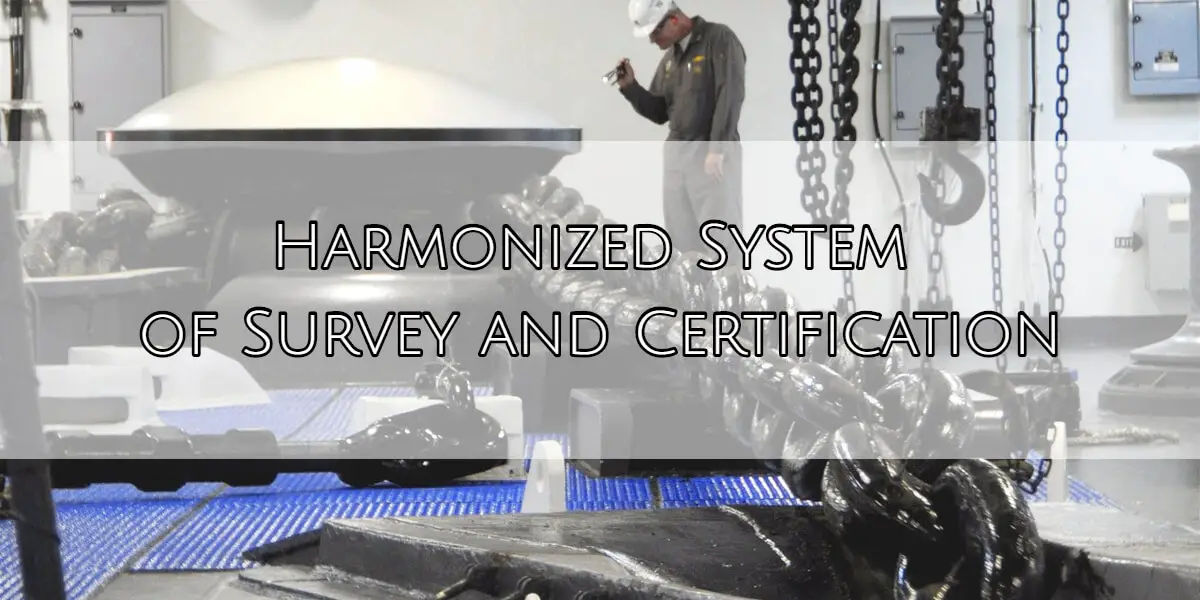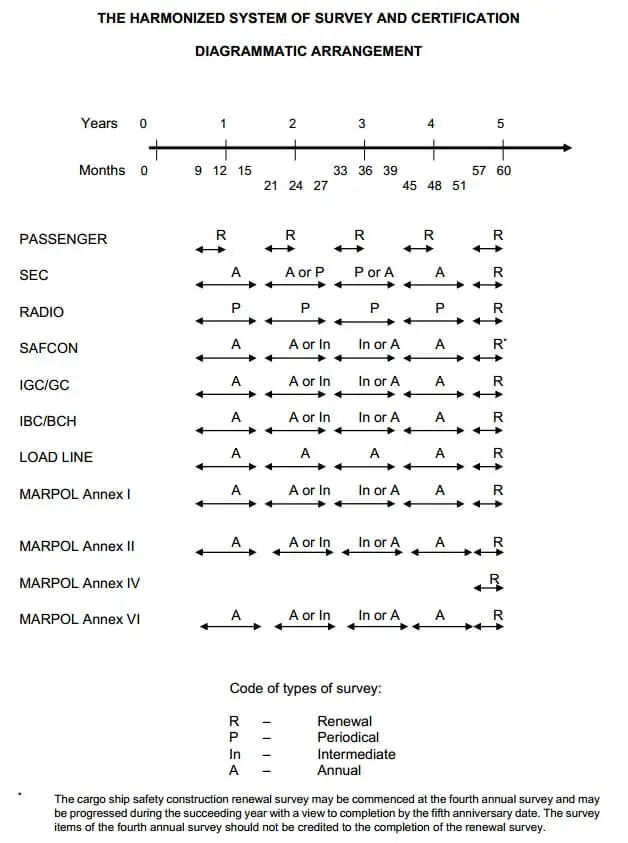A harmonized system of survey and certification covering international shipping regulations adopted by the International Maritime Organization enters into force on 3 February 2000. It harmonizes survey procedures and survey dates for all major ship certificates, instead of having different survey procedures and dates for certificates under different conventions.
Harmonized System of Survey and Certification (HSSC) was brought about with the sole objective of simplifying and systemizing the survey and certification of ships. This will ensure that survey works will not be duplicated e.g. survey for load line or cargo ship safety construction is more or less same with logical changes. If a ship undergoes survey of one, the survey of other will only overlap and once conducted can be valid for both. Needless to say, a single survey covering both certifications will save a lot of time and money. This will also allow the ship to plan the survey in a more relaxed and professional manner. The total number of surveys will be reduced and maintenance and work on board will be more systematic and ships will not be out of service at different times for different surveys. Though it is a mandatory system it is implemented on individual ships on different dates. It may be implemented by the FSA ( Formal Safety Assessment ) on or after 3rd February 2000.
IMO Resolution A.1104 (29) gives the Survey Guidelines under the HSSC system adopted on 2 December 2015.
Harmonized System of Survey and Certification (HSSC) covers the following certification under the modified or amended instruments:
- SOLAS 1974 as modified by its 1988 protocol
- LLC 1966 as modified by its 1988 protocol
- MARPOL 1973 and 1978 as amended by 1990 resolution (MARPOL 73/78/90)
- IBC Code
- IGC Code
- BCH Code
It covers the following certificates:
- Cargo Ship Safety Equipment Certificate
- Cargo Ship Safety Construction Certificate
- Cargo Ship Safety Radio Certificate
- International Load Line Certificate
- International Oil Pollution Prevention Certificate
- International Pollution Prevention Certificate for Carriage of Noxious Liquid Substances in Bulk
- International Sewage Pollution Prevention Certificate
- International Air Pollution Prevention Certificate
- International Certificate of Fitness for the Carriage of Dangerous Chemicals in Bulk or the Certificate of Fitness for the Carriage of Dangerous Chemicals in Bulk
- International Certificate of Fitness for the Carriage of Liquefied Gases in Bulk
- Passenger Ship Safety Certificate
Surveys for the issuance of these certificates, under the SOLAS, MARPOL, the Load Line Convention and the Gas and Chemical Tanker Codes are as follows:
Types of Ship Survey
Initial survey
The initial survey should include a complete inspection, with tests when necessary, of the structure, machinery, and equipment to ensure that the requirements relevant to the particular certificate are complied with and that the structure, machinery, and equipment are fit for the service for which the ship is intended.
The initial survey should consist of:
- an examination of the plans, diagrams, specifications, calculations and other technical documentation to verify that the structure, machinery, and equipment comply with the requirements relevant to the particular certificate.
- an inspection of the structure, machinery and equipment to ensure that the materials, scantlings, construction and arrangements, as appropriate, are in accordance with the approved plans, diagrams, specifications, calculations and other technical documentation and that the workmanship and installation are in all respects satisfactory; and
- a check that all the certificates, record books, operating manuals and other instructions and documentation specified in the requirements relevant to the particular certificate have been placed on board the ship.
Annual survey
General inspection of the items relating to the particular certificate to ensure that they have been maintained and remain satisfactory for the service for which the ship is intended in accordance with the relevant requirements. The annual survey, as required by the relevant regulations should be held within three months before or after each anniversary date of the certificate.
The scope of the annual survey should be as follows:
- it should consist of a certificate examination, a visual examination of a sufficient extent of the ship and its equipment, and certain tests to confirm that their condition is being properly maintained;
- it should also include a visual examination to confirm that no unapproved modifications have been made to the ship and its equipment;
- the content of each annual survey is given in the respective guidelines. The thoroughness and stringency of the survey should depend upon the condition of the ship and its equipment; and
- should any doubt arise as to the maintenance of the condition of the ship or its equipment, further examination and testing should be conducted as considered necessary.
Intermediate survey
The intermediate survey should be an inspection of items relevant to the particular certificate to ensure that they are in a satisfactory condition and are fit for the service for which the ship is intended.
The intermediate survey, as required by the relevant regulations should be held within three months before or after the second anniversary date or within three months before or after the third anniversary date of the appropriate certificate and should take the place of one of the annual surveys.
Periodical survey
Inspection of the items relating to the particular certificate to ensure that they are in a satisfactory condition and fit for the service for which the ship is intended. The periodical survey should also consist of a check that all the certificates, record books, operating manuals and other instructions and documentation specified in the requirements relevant to the particular certificate are on board the ship.
The periodical survey, as required by the relevant regulations should be held within three months before or after the second anniversary date or within three months before or after the third anniversary date in the case of the cargo ship safety equipment certificate and should take the place of one of the annual surveys and within three months before or after each anniversary date in the case of the cargo ship safety radio certificate.
Renewal survey
As per periodical survey but leads to the issue of a new certificate and to be held before the appropriate certificate is renewed.
The cargo ship safety construction renewal survey may be commenced at the fourth annual survey and may be progressed during the succeeding year with a view to completion by the fifth anniversary date. The survey items of the fourth annual survey should not be credited to the completion of the renewal survey.
The renewal survey should consist of:
- an inspection, with tests when necessary, of the structure, machinery, and equipment to ensure that the requirements relevant to the particular certificate are complied with and that they are in a satisfactory condition and are fit for the service for which the ship is intended.
- also consist of a check that all the certificates, record books, operating manuals and other instructions and documentation specified in the requirements relevant to the particular certificate are on board the ship.
- Concurrent crediting to both intermediate and renewal safety construction survey for surveys of spaces should not be acceptable.
Inspection of the outside of the ship’s bottom
There should be a minimum of two inspections of the outside of the ship’s bottom during any five-year period. One such inspection should be carried out on or after the fourth annual survey in conjunction with the renewal of the Cargo Ship Safety Construction Certificate or the Cargo Ship Safety Certificate. Where the Cargo Ship Safety Construction Certificate or the Cargo Ship Safety Certificate has been extended, this five-year period may be extended to coincide with the validity of the certificate. In all cases, the interval between any two such inspections should not exceed 36 months.
The inspection of the outside of the ship’s bottom and the survey of related items should include an inspection to ensure that they are in a satisfactory condition and fit for the service for which the ship is intended. Inspections of the outside of the ship’s bottom should normally be carried out with the ship in a dry dock. However, consideration may be given to alternate inspections being carried out with the ship afloat.
Additional survey
Inspection, either general or partial according to the circumstances, to be made after a repair resulting from casualty investigations or whenever any important repairs or renewals are made.
The harmonized system provides for:
One year standard interval between surveys, based on initial, annual, intermediate, periodical and renewal surveys as appropriate. A scheme for providing the necessary flexibility for the execution of each survey with the provision that:
- the renewal survey may be completed within 3 months before the expiry date of the existing certificate with no loss of the period of validity.
- there is a “window period” of 6 months, from 3 months before to 3 months after the anniversary date of the certificate for annual, intermediate and periodical surveys.
- A maximum period of validity of 5 years for all certificates for cargo ships
- A maximum period of validity of 12 months for the Passenger Ship Safety Certificate
- A system for the extension of certificates limited to 3 months to enable a ship to complete its voyage or one month for ships engaged on short voyages
- The period of validity of the new certificate starts from the expiry of the existing certificate before its extension if the extension was granted
- A flexible system for the inspection of the outside of the ship’s bottom on the following conditions:
1. a minimum of two inspections during any 5 year period
2. the interval between any two such inspections may not exceed 36 months
- A provision for a Cargo Ship Safety Certificate, as an alternative to separate Cargo Ship Safety Construction, Cargo Ship Safety Equipment and Cargo Ship Radio Certificates.
- A flexible system concerning the frequency and the period of validity of certificates provided that the minimum pattern of the survey is maintained.


These are very important articles. From a small island state, where IMO meetings are hard for us to attend, these items help us to know more apart from the workshops held by IMO.
Thank-you Starling. It gives us immense pleasure to know that our humble efforts are helpful to you and learners around the globe.
Hi, I am from Malaysia, may I know what should I do in order to apply for this HSSC system? Is it I need to write a letter of request to the flag?
Thanks in advance!
Hello Kay, yes, the request to apply for harmonized survey, should be submitted to the class, following the request, the class will ask you to complete the documentation, if you search for “Application for Surveys and Issue of Certificates Form 2A – Class NKK” It will give you an fair idea about it.
What is the different between Periodical survey and Intermediate survey ???
As far as i am concerned that the different periodical survey is used on CSSEC and CSSRC & intermediate survey is for the rest but not use for passenger and LL. More details, See diagrammatic arrangement
What are all the CERTIFICATES are not covered in HSSC? And why?